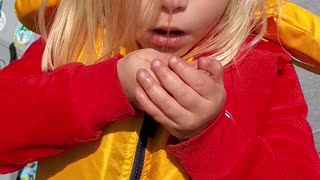Premium Only Content

Dolphin kisses a little girl and brings her a gift
An adorable little girl kisses the Dolphins.
As the crowd watches on an adorable little girl in a small orange and white boat with the supervision of a woman. She greets the dolphins as they swim up to meet her. The little girl leans over and gave the dolphins a lovely greeting. The dolphins show their appreciation by bringing a gift to the beautiful little girl and gets a kiss from her, it's a heartwarming event that you have to see for yourselves.
Dolphins are small-toothed cetaceans easily recognizable by their curved mouths, which give them a permanent “smile.” There are 36 dolphin species, found in every ocean. Most dolphins are marine and live in the ocean or brackish waters along coastlines. There are a few species, however, like the South Asian river dolphin and the Amazon river dolphin, or boto, that live in freshwater streams and rivers.
The largest dolphin, the orca, can grow to be over 30 feet long. The smallest, the Maui dolphin, is just five feet long.
Dolphins feed chiefly on fish and squid, which they track using echolocation, a built-in sonar that bounces sound waves off prey and reveals information like its location, size, and shape. An echolocating bottlenose dolphin can make up to a thousand clicking noises per second.
Behavior and reproduction
Living in pods that can number a dozen or more, dolphins are intensely social mammals that communicate with squeaks, whistles, and clicks. Whether dolphins have language, as humans do, is a topic that scientists have debated for decades.
As mammals, they have warm blood and nurse their young. Dolphins have more than one mate, and generally produce a single offspring that will stay with the mother for up to six years, depending on the species.
Dolphins are graceful, sleek swimmers that can reach speeds of more than 18 miles an hour. They are also playful and often frolic in a boat’s wake, leaping out of the water—possibly for fun, to communicate, or even shed pesky parasites.
Threats
For centuries, people have hunted dolphins for their meat and blubber. Today, their main threat comes from being caught accidentally in commercial fishing nets. Dolphins must rise regularly to the surface to breathe—becoming entangled in nets prevents this, leading to drowning. For maine dolphins, warming ocean temperatures because of climate change have caused some of their primary food sources to move into deeper, cooler water. Furthermore, marine heatwaves, also caused by climate change, appear to have a negative affect on dolphins' reproductive rates and ability to survive.
In addition to hunting and entanglement in fishing gear, freshwater dolphins face the additional threat of dams fragmenting and degrading habitat.
-
 0:18
0:18
x4xbazzyx4x
3 years agoLittle Girl Kisses Worm and throws Him in the Water
481 -
 UPCOMING
UPCOMING
Man in America
5 hours agoThe DISTURBING Truth: How Seed Oils, the Vatican, and Procter & Gamble Are Connected w/ Dan Lyons
5.79K2 -
 6:46:07
6:46:07
Rance's Gaming Corner
7 hours agoTime for some RUMBLE FPS!! Get in here.. w/Fragniac
107K1 -
 DVR
DVR
Josh Pate's College Football Show
6 hours ago $2.83 earnedCFP Reaction Special | Early Quarterfinal Thoughts | Transfer Portal Intel | Fixing The Playoff
16.1K -
 23:55
23:55
CartierFamily
3 days agoElon & Vivek TRIGGER Congress as DOGE SHUTS DOWN Government
61.3K76 -
 5:43:44
5:43:44
Scammer Payback
2 days agoCalling Scammers Live
146K21 -
 18:38
18:38
VSiNLive
2 days agoProfessional Gambler Steve Fezzik LOVES this UNDERVALUED Point Spread!
109K17 -
 LIVE
LIVE
Right Side Broadcasting Network
10 days agoLIVE REPLAY: President Donald J. Trump Keynotes TPUSA’s AmFest 2024 Conference - 12/22/24
5,099 watching -
 4:31
4:31
CoachTY
1 day ago $26.84 earnedCOINBASE AND DESCI !!!!
158K11 -
 10:02
10:02
MichaelBisping
23 hours agoBISPING: "Was FURY ROBBED?!" | Oleksandr Usyk vs Tyson Fury 2 INSTANT REACTION
84.1K13